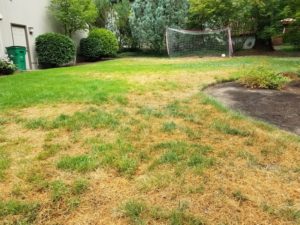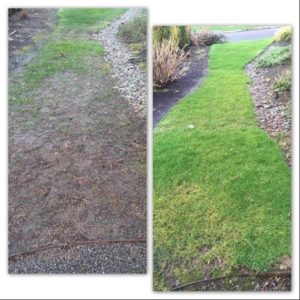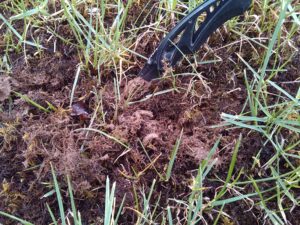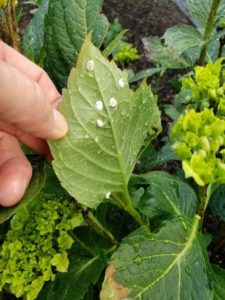What happened to my lawn? Brown Patches – Common causes and what to do about them.
The dreaded brown patch. No lawn is immune. From lawns receiving minimal care to those that are perfectly tended by their owners, patches of dead or dying grass can appear seemingly overnight. Why? What causes these brown spots?
We get this question a lot! Here are some answers.
Watering too Little (or too Much!) Underwatering and overwatering are both probable causes for brown or dying grass. Underwatering creates drought-like conditions when there isn’t enough rain to keep roots alive, and causes grass to die off. Yes, grass naturally goes dormant after a few weeks without water, and most lawns can tolerate drought conditions for a short time (although they will turn brown). However, extended periods of hot dry conditions like we can see here in late summer may kill a lawn.
Too much water can also be a problem. Daily watering can lead to overly saturated soil if sprinklers are left on too long. Overwatering like this will suffocate the grass and stunt root growth. Conversely, frequent shallow irrigation can also result in a weak root system that is susceptible to drought and disease.
Ideally, lawns should be watered deeply averaging 1 to 1 ½ of water a week depending on the temperatures.
Poor Irrigation Coverage Brown patches can also be caused when an irrigation system isn’t properly adjusted to account for the different zones within a lawn. Poor irrigation coverage can lead to some spots being overwatered, green, and soggy while leaving other spots to dry out and go dormant.
A properly adjusted irrigation system is key to a healthy lawn.
Improper Mowing Grass length, as well as frequency of mowing, are important factors to maintaining a healthy lawn. Infrequent mowing requires a deeper cut to return grass to the proper length, which in turn can actually stop a lawn from growing or require additional watering to recover. As a good rule of thumb, you never want to cut more than a third of the length. On the other hand, keeping your lawn too short can stress the grass and cause it to turn brown, especially during the dry season.
Most turfgrass should be kept to a length between 2 and 3 inches. Regular mowing is the answer and will help keep your lawn healthy and resistant to damage.
Thatch Build-up Thatch is the organic layer of debris that accumulates between the soil and the grass blades in your lawn. Some thatch is normal, and a thin layer will make the grass more resilient to wear and temperature extremes. Too much thatch, however, can be the root cause of brown spots as it weakens your lawn and makes it more susceptible to pests and disease. A layer of thatch thicker than half an inch will restrict airflow and can prevent water and nutrients from reaching the soil. Grass roots will also start to spread in thatch that is too thick, instead of the soil.
A common misperception is that grass clippings lead to the build-up of thatch, but poor soil conditions, and over-fertilization, can result in excessive thatch build-up.
Dethatching becomes necessary when the layer of thatch is too thick. But a word of caution: the best time to dethatch may not be when you notice your lawn turning brown. Dethatching is most effective and causes the least amount of stress on your lawn during the active growing season.
Poor Soil Quality The health of your lawn is largely dependent on the condition of the soil. Poor soil quality, such as compacted or nutrient deficient soil can leave the root system weakened and your lawn vulnerable to insects and disease. In addition, pH levels may not be optimal for your grass. Aerating your lawn and amending the soil can make a difference, but your best approach is to first test your soil. There’s no sense in taking measures that don’t address the underlying causes of an unhealthy lawn.
Insects Weakened lawns – due to any of the above – are prone to insect infestation. Brown patches and areas of dead grass can be telltale signs. If you have brown spots, try pulling up a small area of turf. Pest-infested grass will pull up easily because the roots are damaged. Grubs and larvae are the most prevalent lawn pest and they love to munch on roots! Check out our previous blog on Crane Flies for tips on treating and preventing an infestation.
Fungus Irregular patches of brown spots in your lawn could also be the result of a fungus. Hot, humid conditions, as well as lack of sunlight and poor air circulation, can create ideal conditions for a fungal outbreak. Low nitrogen levels and lack of fertilizer in the soil is another factor that can lead to a fungus problem. Watering in the evening, when the grass may not be able to properly dry is another cause.
Dethatching and aerating, maintaining optimal nitrogen levels, and proper watering can all help discourage fungal growth.
So, what is causing brown spots in your lawn? As you can see, it could be any one of a number of factors! The good news is that whatever the cause, brown spots can be addressed, and your lawn can be returned to a healthier state. If your lawn is plagued with brown spots and the cause has you stumped, we can help. We offer complete lawn care services, including diagnosis of problems, soil testing, and irrigation system maintenance and repairs. Contact Landscape East & West today and let our lawn care experts help you.
